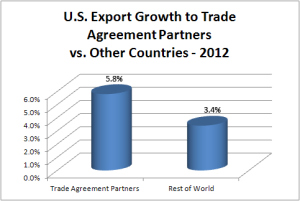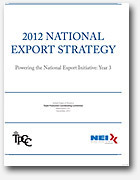This post contains external links. Please review our external linking policy.
Francisco Sánchez serves as the Under Secretary of Commerce for International Trade. Mark Doms serves as the Under Secretary of Commerce for Economic Affairs. This post also appears on the Department of Commerce blog.
Last year was another record-setting year for U.S. exporters.
Data released today show that in 2012, American exports totaled $2.2 trillion, eclipsing the previous record of $2.1 trillion in exports in 2011.

Data from the Department of Commerce show that U.S. exports in 2012 totaled $2.2 trillion, a record for American exports.
This represents more than just numbers on a spreadsheet; it’s further proof that “Made in the USA” products are in demand all over the world. It also means that more U.S. businesses are seizing the great opportunities in the global markets, continuing to help pave our nation’s road to economic recovery.
The increase in U.S. exports continues an upward trend that began in 2009. This trend has contributed to the creation of 6.1 million American private-sector jobs during the last 35 months. It is a direct result of President Obama’s National Export Initiative, part of a government strategy to strengthen our economy, support the creation of American jobs, and ensure long-term growth.
We are making historic progress toward the President’s goal of doubling exports by the end of 2014. Data show significant export growth in agriculture, motor vehicles, aerospace, and travel and tourism. The U.S. also continued to dominate exports in the services industry, worth over $632 billion, an increase of $26.4 billion over the previous year. This gave us a $195 billion trade surplus for services, which is a record surplus for the services industry.
 There was significant growth in trade with the 20 countries sharing trade partnerships with the U.S. Exports to these countries grew at nearly twice the rate of exports to the rest of the world and represented nearly half of all U.S. exports in 2012. Exports to Panama and Colombia, two countries with which the U.S. entered trade agreements in 2012, achieved record highs.
There was significant growth in trade with the 20 countries sharing trade partnerships with the U.S. Exports to these countries grew at nearly twice the rate of exports to the rest of the world and represented nearly half of all U.S. exports in 2012. Exports to Panama and Colombia, two countries with which the U.S. entered trade agreements in 2012, achieved record highs.
U.S. businesses continue to face the challenge of slow growth in the global economy. That is why the Obama administration continues to do everything possible to support American farmers, workers, and businesses as they compete in the global marketplace. As the record data show, this work benefits American exporters and the U.S. economy.
We will continue to expound on the data here on the Tradeology blog, the Economic Statistics Administration blog, and on Twitter. You can also find a copy of the data here.



